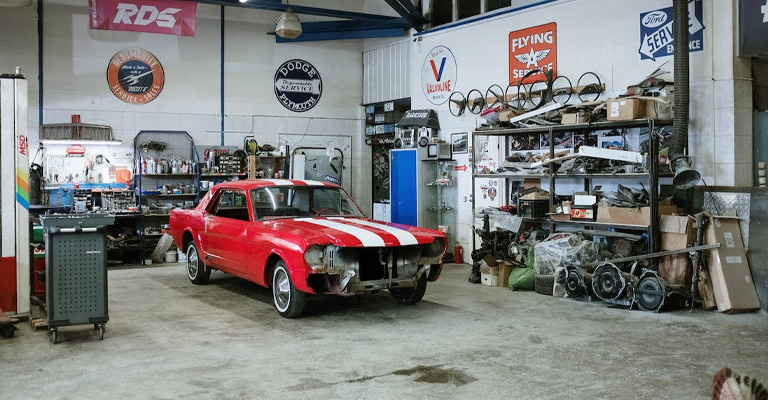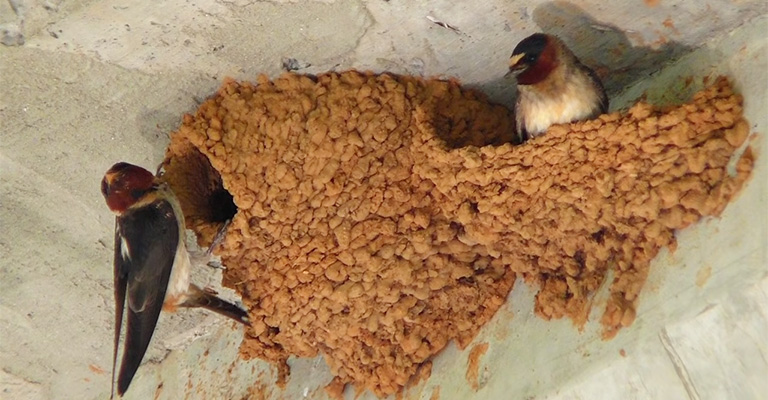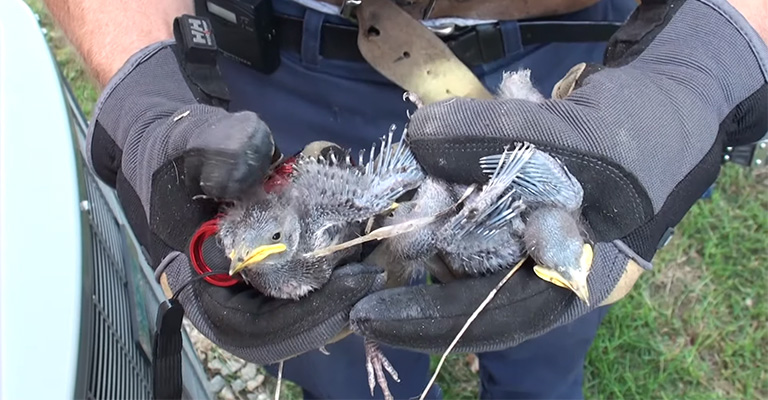Discovering a bird has found its way into your garage can be both surprising and challenging. As these winged visitors seek shelter or become disoriented by reflections, the task of guiding them back to the outdoors requires patience, empathy, and practical strategies.
Ensuring a safe exit for the bird while safeguarding your property forms the heart of this endeavor. From creating exit paths to utilizing natural instincts, a holistic approach is vital to successfully addressing the situation.
This article delves into how to get rid of birds nest, exploring various methods that balance human intervention with the well-being of these feathered creatures.

How To Get A Bird Out Of Your Garage? [9 Methods]
If you have a bird trapped in your garage, you may want to get it out as soon as possible.
Birds can be noisy, messy, and potentially harmful to your property or health. However, you should also be careful not to harm or stress the bird while trying to remove it.
Here are nine methods you can try to get a bird out of your garage safely and humanely:
Create An Opening
The simplest and most natural way to get a bird out of your garage is to create an opening for it to fly out. Open the garage door and any windows that are accessible to the bird. Turn off any lights or fans that may confuse or distract the bird.
Then, leave the garage and wait for the bird to find its way out. This may take some time, so be patient and check on the bird periodically.
Trap And Catch
If the bird does not leave on its own, you may need to catch it and release it outside. You can use a fishing net, a butterfly net, or a blanket to catch the bird mid-flight or when it is perched.
Be gentle and avoid squeezing or injuring the bird. Once you have caught the bird, carry it outside and let it go.
Paint Garage Door
Sometimes, birds may mistake your garage door for the sky and fly into it repeatedly. This can injure the bird and damage your door.
To prevent this, you can paint your garage door a different color or add some patterns or stickers to it. This will make the door more visible and less attractive to the birds.
Remove The Nest
If the bird has built a nest in your garage, you may need to remove it before the bird leaves. However, you should only do this if the nest is inactive, meaning there are no eggs or baby birds in it.
Removing an active nest may be illegal and harmful to the birds. To remove an inactive nest, use gloves and a mask to protect yourself from any parasites or diseases that may be in the nest.
Gently detach the nest from its location and place it in a plastic bag. Tie the bag securely and dispose of it in a trash can away from your house.
Feed Birds Outside
One way to lure the bird out of your garage is to feed it outside. Place some bird seed or fruit near the exit of your garage and wait for the bird to notice it.
The bird may be hungry or curious and fly toward the food source. Once the bird is outside, close the door behind it.
Lure With Vibrant Colors
Some birds are attracted to bright colors, especially red. You can use this to your advantage by placing a red object near the exit of your garage, such as a feeder, a flower, or a toy.
The bird may be drawn to the red object and fly towards it. Alternatively, you can use reflective objects, such as mirrors, CDs, or foil, to create flashes of light that guide the bird toward the exit.
Bird Repellent Spray
If none of the above methods work, you may need to use a bird-repellent spray to discourage the bird from staying in your garage.
You can buy a commercial spray that contains natural ingredients that birds dislike, such as peppermint oil, garlic oil, or vinegar.
Spray the repellent around the areas where the bird likes to perch or nest, but avoid spraying it directly on the bird or its eyes.
Cover Holes
Another way to prevent birds from entering your garage is to cover any holes or gaps that they may use as entry points.
You can use mesh, wire, foam, or wood to seal off any openings that are larger than 2 inches in diameter. This will also help keep out other pests, such as rodents or insects.
Utilizing A Rake
Rake can be a useful tool to reach a bird that is perched high up in your garage and guide it toward the exit. Extend the rake towards the bird and let it perch on the handle.
Then, slowly lower the rake and move it towards the door or window. These are some of the methods you can try to get a bird out of your garage without harming it or yourself.
Remember to be patient and gentle with the bird and respect its natural instincts. If all else fails, you can always call a professional animal control service for help.
Why Do Birds Enter Your Garage?

Birds can find their way into your garage for various reasons, often driven by instincts, environmental factors, or simple curiosity.
Understanding these motivations can help you take preventive measures to avoid future intrusions:
Shelter and Nesting
Garages provide shelter from the elements, making them attractive to birds seeking refuge from harsh weather conditions. They might also view the space as a potential nesting site due to its enclosed nature.
Food Sources
Garages can inadvertently attract birds when they offer access to food. Leftover pet food spilled birdseed, or even insects drawn to garage lights can lure hungry birds inside.
Light and Reflections
Birds are naturally attracted to light and can become disoriented when they mistake windows or reflective surfaces for open spaces. This confusion can lead them to fly into garages.
Exploration
Curiosity drives some birds to explore unfamiliar environments. An open garage door might entice birds to venture in, driven by their innate curiosity to investigate new areas.
Warmth and Comfort
In colder climates, birds might seek out garages for warmth. Vehicles that were recently driven can emit residual heat, making the garage a cozy spot for birds to rest.
Escape From Predators
If a bird is pursued by a predator, such as a larger bird or a cat, it might flee into an open garage as a means of escape.
Mistaken Entry
Birds may accidentally fly into garages, mistaking them for openings in outdoor spaces. Bright sunlight or dimly lit interiors can contribute to this confusion.
Attraction to Colors
Birds, especially during the breeding season, are drawn to vibrant colors. Items within your garage, such as tools with brightly colored handles, could intrigue them and lead them inside.
Unintentional Traps
Open doors or windows can create unintentional traps if birds fly in but struggle to find their way out. Their innate territorial instincts can also make it difficult for them to navigate the same entry point.
Sound Reflections
Birds communicate using sounds, and garage interiors can sometimes amplify and reflect these sounds, making it seem like other birds are present and encouraging them to investigate.
By identifying these reasons, you can take steps to address them and make your garage less inviting to birds.
Keep doors and windows closed, secure food sources, and use visual deterrents to prevent birds from entering your garage in the first place.
Why Should We Keep Birds Out of the Garage?

Keeping birds out of the garage is essential to maintain both the integrity of your property and the well-being of the birds themselves.
While birds are valuable members of ecosystems, their presence in certain areas can lead to various issues:
Structural Damage
Bird droppings and nesting materials can accumulate over time, causing damage to surfaces and structures. Corrosive properties in bird droppings can degrade paint, wood, and metal, potentially leading to costly repairs.
Health and Hygiene Concerns
Accumulated bird droppings can carry harmful bacteria, fungi, and parasites, posing health risks to humans and pets. Inhaling particles from dried droppings can trigger respiratory issues.
Fire Hazards
Birds often gather twigs and flammable materials for nests. Nests built near electrical equipment or lighting fixtures can become fire hazards if ignited by heat or sparks.
Obstructed Ventilation and Drainage
Nests’ built-in vents, gutters, or other openings can obstruct proper ventilation and drainage, leading to moisture buildup, mold growth, and potential water damage.
Noise and Disturbance
Active nests can result in noisy bird activity, which can be disruptive if the garage is adjacent to living spaces. Constant noise can also disturb your peace and concentration.
Allergens and Pests
Accumulated bird materials can attract insects and pests that thrive in such environments, increasing the risk of infestations that can extend beyond the garage.
Aesthetic and Resale Value
The presence of bird nests and droppings can diminish the aesthetic appeal of your property. This can negatively impact curb appeal and potentially lower resale value.
Recurring Nests
Birds often return to the same nesting sites each year. Addressing the issue promptly can prevent the recurrence of unwanted nests in the future.
Legal and Ethical Considerations
Some bird species are protected by law, making it important to handle their nests and removal ethically and within the bounds of regulations.
Respect for Wildlife
Encouraging birds to nest in more appropriate locations can prevent them from being disturbed during their breeding and nesting seasons, contributing to their overall welfare.
Balancing human needs with respect for wildlife is crucial. Ensuring that birds do not nest in areas that could cause harm or inconvenience benefits both your property and the avian inhabitants.
By taking proactive steps to prevent birds from entering the garage, you promote a healthier and safer living environment for all.
Why Should We Keep Birds Out of the Garage?

Keeping birds out of the garage is not only about preserving your property but also about maintaining a harmonious living environment for both humans and birds.
Here are the key reasons why it’s important to prevent birds from entering your garage:
Structural Integrity
Bird droppings contain corrosive substances that can damage surfaces over time. Nests built in vents, gutters, or other openings can obstruct proper ventilation and drainage, leading to structural deterioration and potential repairs.
Health Concerns
Bird droppings can carry pathogens and parasites that pose health risks to humans. Inhalation of dried droppings can lead to respiratory problems, making it important to prevent their accumulation in indoor spaces.
Fire Hazards
Birds often use flammable materials for nesting, and nests near electrical fixtures or equipment can become fire hazards. Preventing nests in such locations helps reduce the risk of fires.
Aesthetic Appeal
The presence of bird nests and droppings can detract from the appearance of your property. Stains and messes can diminish curb appeal and impact the overall visual appeal of your home.
Noise Disturbances
Active nests can lead to constant noise and bird activity, which can disrupt your peace and quiet. This is especially relevant if your garage is connected to living spaces.
Pest Attraction
Nests and droppings can attract insects and pests that thrive in such environments. Preventing bird access helps reduce the potential for infestations that could extend beyond the garage.
Respect for Wildlife
Encouraging birds to nest in more appropriate locations ensures that they are not disturbed during their breeding and nesting periods. This respects their natural behaviors and contributes to their overall well-being.
Legal and Ethical Considerations
Some bird species are protected by laws, making it important to handle their nests and removal in an ethical and compliant manner.
Adhering to regulations demonstrates responsible behavior toward wildlife.
Homeowner Costs
The damage caused by bird-related issues can lead to significant repair expenses. By preventing birds from entering the garage, you can avoid unnecessary financial burdens.
Preservation of Property Value
Maintaining a bird-free garage helps uphold the value of your property. A clean and well-maintained environment is more appealing to potential buyers and maintains a positive impression in your neighborhood.
Keeping birds out of the garage is a multifaceted consideration that encompasses health, safety, aesthetics, and ethical responsibility.
By taking steps to prevent bird access, you contribute to the well-being of both your property and the avian inhabitants.
FAQ
Approach slowly and avoid sudden movements or loud noises. Keep your presence non-threatening and provide the bird with a clear path toward the exit.
Yes, turning off bright lights and opening windows or doors can create a clear path toward natural light, which can attract the bird’s attention and guide it outside.
Yes, playing recorded bird calls near the open exit can encourage the bird to move in that direction, as it might think other birds are present.
If the bird is injured, contact local wildlife rescue organizations. For unresponsive birds, provide time and space. If it doesn’t respond after a while, consider seeking professional help.
Install screens on windows and vents, seal gaps in doors, and ensure doors are closed when not in use. Regularly clean up food sources and nesting materials to discourage birds from seeking shelter in your garage.
Conclusion
Guiding a bird out of your garage is a compassionate exercise that showcases our ability to coexist with nature.
By employing a range of techniques, from utilizing light and sound to creating clear exit pathways, you can effectively encourage the bird to find its way back into its natural habitat.
Balancing our convenience with the bird’s safety emphasizes the importance of understanding and respecting wildlife.
This process serves as a reminder of our interconnectedness with the world around us, where patience, gentleness, and environmental awareness converge to ensure a harmonious outcome.
As the bird finally takes flight and returns to the skies, we’re reminded of the delicate balance between human spaces and the broader ecosystem we share.